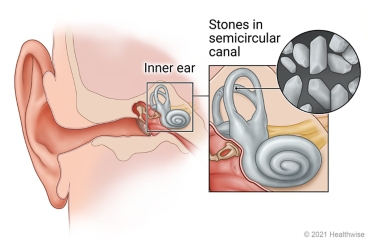
Overview
Benign paroxysmal positional vertigo, also called BPPV, is an inner ear problem. It causes a spinning or whirling sensation when you move your head. This sensation is called vertigo.
The vertigo usually lasts for less than a minute. People often have vertigo spells for a few days or weeks. Then the vertigo goes away. But it may come back again. The vertigo may also cause unsteadiness, nausea, and vomiting. You may be at risk for falls.
When you move, your inner ear sends messages to the brain. This helps you keep your balance. Vertigo can happen when tiny calcium "stones" move into an area of your inner ear called the semicircular canal. This can cause the inner ear to send the wrong message to the brain.
Your doctor may move you in different positions to help your vertigo get better faster. This is called the Epley maneuver. Your doctor may also prescribe exercises for you to do on your own.
Follow-up care is a key part of your treatment and safety. Be sure to make and go to all appointments, and call your doctor if you are having problems. It's also a good idea to know your test results and keep a list of the medicines you take.
How can you care for yourself at home?
Vertigo causes loss of balance and puts you at risk for falling. Be extra careful so that you don't hurt yourself or someone else if you have a sudden attack of vertigo.
- Don't drive or ride a bike if you are having vertigo.
- Keep floors and walkways free of clutter so you don't trip.
- Avoid heights.
Your doctor may suggest that you do the Epley maneuver at home. Here's how:
- Sit on the edge of a bed. Turn your head halfway between looking straight ahead and looking to the side that causes the worst vertigo (45 degrees).
- Tilt yourself backward until you are lying on your back. Your head should stay at the 45-degree turn. Hold for 30 seconds. If you have vertigo, stay in this position until it stops.
- Turn your head all the way to the other side without lifting it. Your chin should be raised and over your shoulder. Hold for 30 seconds or until your symptoms stop.
- Keeping your head in the same position, roll your body the same direction you are facing. You should now be on your side and looking down. Hold for 30 seconds or until your symptoms stop.
- Slowly push yourself up to a sitting position.
When should you call for help?
Call 911 anytime you think you may need emergency care. For example, call if:
- You passed out (lost consciousness).
- You have sudden dizziness that doesn't get better.
- You have dizziness along with symptoms of a heart attack. These may include:
- Chest pain or pressure, or a strange feeling in the chest.
- Sweating.
- Shortness of breath.
- Nausea or vomiting.
- Pain, pressure, or a strange feeling in the back, neck, jaw, or upper belly or in one or both shoulders or arms.
- Lightheadedness or sudden weakness.
- A fast or irregular heartbeat.
- You have symptoms of a stroke. These may include:
- Sudden numbness, tingling, weakness, or loss of movement in your face, arm, or leg, especially on only one side of your body.
- Sudden vision changes.
- Sudden trouble speaking.
- Sudden confusion or trouble understanding simple statements.
- Sudden problems with walking or balance.
- A sudden, severe headache that is different from past headaches.
Call your doctor now or seek immediate medical care if:
- You have new or worse nausea and vomiting.
- You have new symptoms such as a fever, a headache, hearing loss, or ringing in your ears.
Watch closely for changes in your health, and be sure to contact your doctor if:
- You are not getting better as expected.
Where can you learn more?
Go to http://www.healthwise.net/patientEd
Enter P372 in the search box to learn more about "Benign Paroxysmal Positional Vertigo (BPPV): Care Instructions".
Current as of: September 27, 2023
Author: Ignite Healthwise, LLC Staff
Clinical Review Board
All Healthwise education is reviewed by a team that includes physicians, nurses, advanced practitioners, registered dieticians, and other healthcare professionals.

